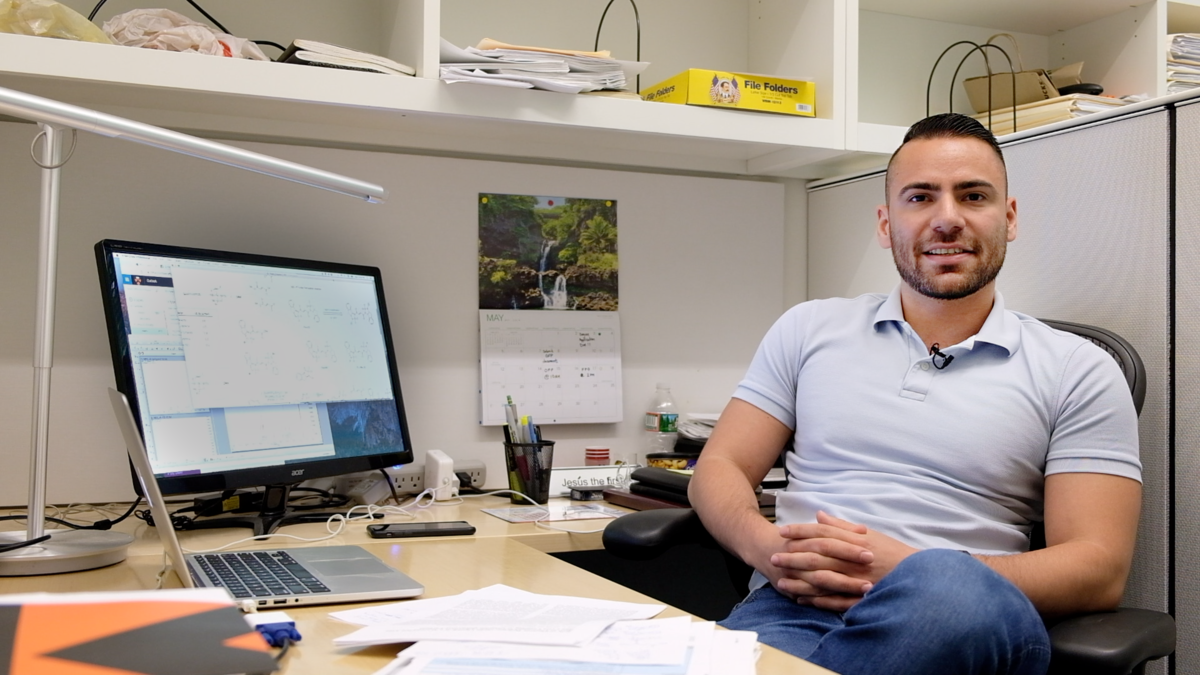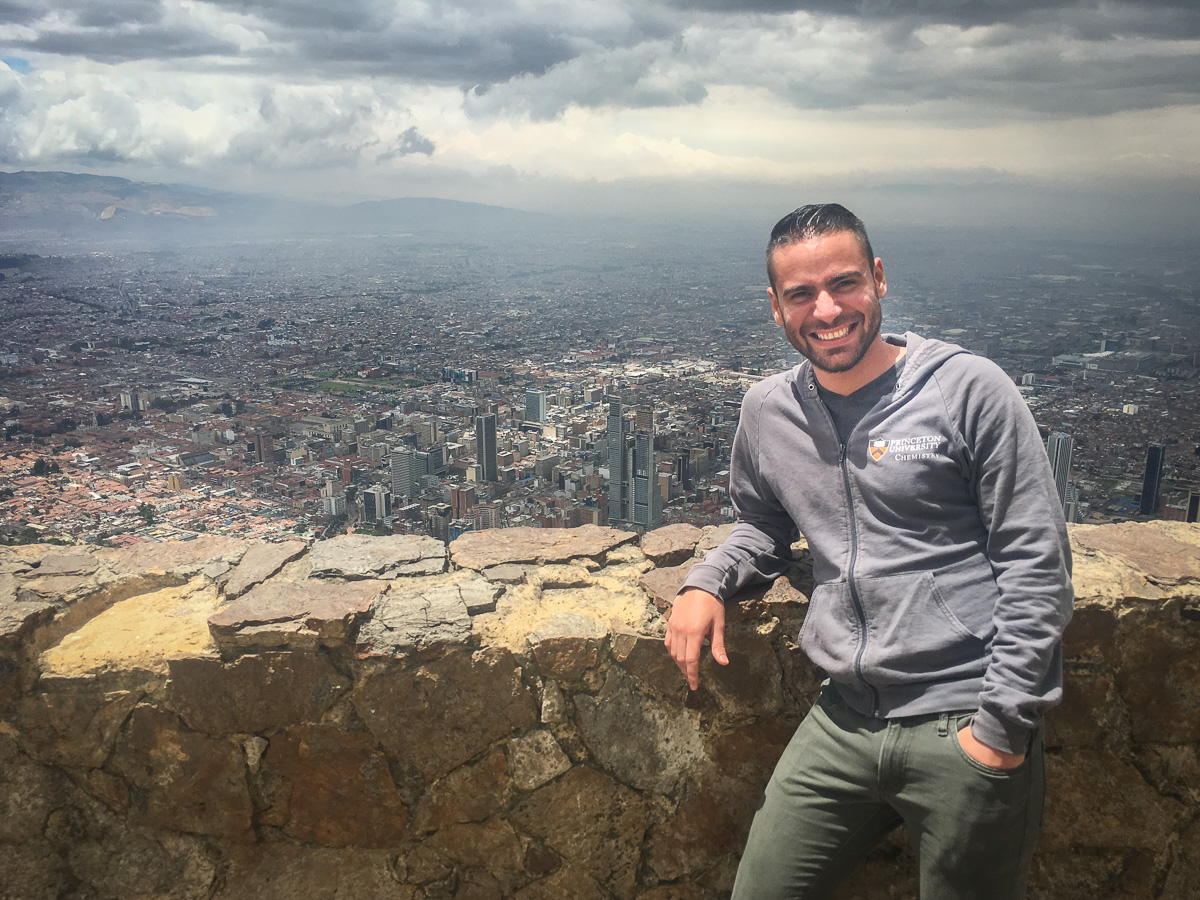Estrada: Chem Ph.D., Merck Scientist, “Dreamer”
Jesús Estrada’s father got his United States citizenship at a highly inopportune moment. Estrada had just turned 21. Suddenly labeled an adult in his own right, he was no longer a beneficiary of his father’s new status and the privilege it conferred on immediate family members. With the turn of a calendar page, Estrada’s wait-time for a green card went from seven months to seven years.
And then came DACA, the Deferred Action for Childhood Arrivals program. Which changed everything.

Photo by C. Todd Reichart
The string of events that followed – a long-awaited trip to the Colombia of his childhood, admission to graduate school at Princeton’s Department of Chemistry, a Ph.D. in 2019, a great job at Merck – seem now to have arisen from that enabling program, called into being in 2012 by then-President Barack Obama.
But that’s too narrow a description of Estrada’s experience. He was always determined to find ways “to not stop doing chemistry.” DACA just helped him do that.
“At no point did I ever feel, all right, this is not working out so let me stop chemistry and do something else,” said Estrada during a phone interview from his home in Jersey City. “I always continued studying chemistry. I saw opportunities arise and I just sort of went for them.
“Still, if things had moved even six months faster for my father, I would have gotten my green card by the age of 21.”
Estrada, now a senior scientist at Merck, is the lead author on a paper recently published in the Journal of the American Chemical Society (JACS), a mechanistic study on the role of electron-deficient ligands in a Nickel cross-coupling reaction. An unexpected computer-based observation led Estrada and co-workers to divine the unique properties of a new ligand class developed by the Doyle group. He first undertook the research after arriving at the department in 2014 under the advisement of Abigail Doyle, professor of chemistry. But the work was foundering, so he temporarily pursued other research.
Eventually, though, Estrada picked up the thread of his Nickel catalysis work, this time pushing through to its conclusion.
“His great success the second time around can be attributed to a combination of having a fresh pair of eyes on the data, additional experience, and confidence to learn and apply new techniques and experiments, as often happens as you grow as a scientist,” said Doyle.
The JACS paper puts an exclamation point to the perseverance of so many “Dreamers” like Estrada, students of immigrant parents who accessed DACA to finish their educations in the country they have always called home. DACA permits undocumented students who arrived in the United States as children to obtain temporary protection from deportation, allowing them to continue their studies or to work in the United States.
In 2017, the Trump Administration announced plans to terminate the DACA program. Princeton University has been an advocate for the program since its inception: President Christopher L. Eisgruber wrote an open letter to President Donald Trump in 2017, and undertook a trip to Washington, D.C. last November to hear oral arguments at the U.S. Supreme Court challenging the government’s plans. Finally, on Thursday, June 18, 2020, the Supreme Court ruled against the Trump Administration’s plans to end DACA, restoring DACA status to over 700,000 young program beneficiaries – known as “Dreamers” – across the country. The University will continue to urge Congress to enact a legislative solution that provides permanent legal protections for the full population of Dreamers.
“It was super hot”
Born in Colombia, Estrada was 7 years old in 1995 when his parents brought him to the United States. He grew up in Jackson Heights outside New York City, plunked down in the middle of a pronounced Colombian culture. It was there that he developed his identity as both Latino and New Yorker. Estrada graduated from the prestigious Macaulay Honors College at the City University of New York in 2010, and later pursued his master’s degree in chemistry from Brooklyn College under the advisement of Professor Roberto Sanchez-Delgado.

Photo courtesy of Jesús Estrada
But as he turned 21 and faced the prospect of waiting years for a green card, Estrada’s education stalled. Unable to work legally, unable to pursue his doctorate legally, he waited, doing chemistry research in Sanchez-Delgado’s lab and working weekends as a bartender.
Then, suddenly, there was a program called DACA.
“Oh my God! So, I remember when I heard Obama speaking about this during a press conference,” said Estrada. “I couldn’t believe it. I couldn’t believe it because, based on the benefits it granted, I realized I could do basically everything that I wanted to do.
“I remember it was the summer of early 2012 and I think applications were going to start being received in August or September. I think I submitted my application a week after. I must have been one of the first applicants.”
Estrada’s DACA application was approved in October of 2012. He finished his master’s degree the following summer and applied for graduate school to Princeton. He started at the University in fall 2014. Two years later, when he finally received his green card, he went to Doyle and said he simply had to take a three-week trip to Colombia.
“She was good with that. She was supportive. I had not seen my big brother in over 15 years, and I never really had a connection with cousins and aunts and uncles,” said Estrada. “So, I wanted to go back to see who these people were. I received the actual green card in the mail on Sept. 30th. On Oct. 8th, I was already flying to Colombia.”
Estrada was greeted at the airport by his older brother and family members. “The first thing I thought was, it was super hot. And the second was, am I really here? It was beautiful. It was awesome.”
DACA as tool
Estrada has been a senior scientist at Merck in Rahway, New Jersey, for nearly nine months now, working on the development of a long-term commercial route for a drug candidate currently in clinical trials. It was during his early months there that he began to appreciate the rigorous training he’d received at Princeton. It enabled him to be “the scientist I wanted to be,” he said. The recently published JACS paper formed the bulk of his doctoral research, a project that Estrada said he never really gave up on but kept in the back of his mind until a new approach occurred to him.
He considers the difficulty of that early research as a reflection of his immigrant experience. That experience spans a childhood in elementary school when he hid the fact that he was undocumented, to a return to Colombia where relatives called him “the American,” to his clear identity today as a New Yorker.
“I see this paper as my experience, overall – my experience as an immigrant. I describe the paper in terms of putting a whole bunch of tools together to really understand the question, because five years of graduate school is a very long time to be thinking about a research problem.
“That’s how I see DACA. I see it as a tool. I think DACA is the tool I used to get to where I am now,” said Estrada. “If I think about it, in a way my immigrant life taught me there might not be a solution that is very clear, so what can you do to really figure this out? And if you put those two analogies together, that’s the experience I had.”
